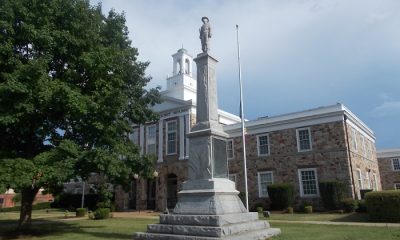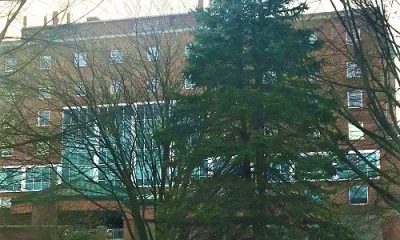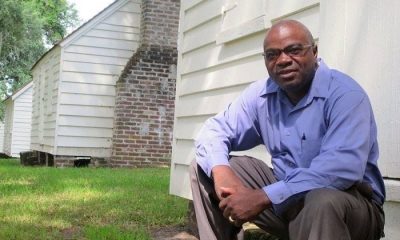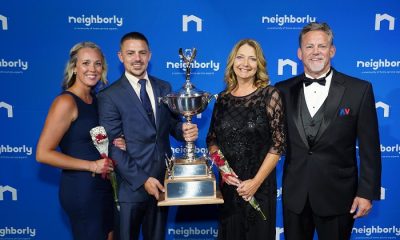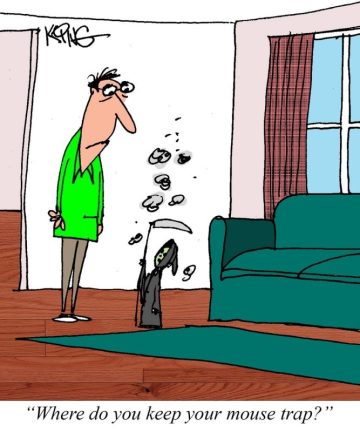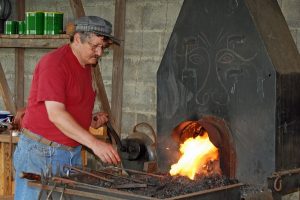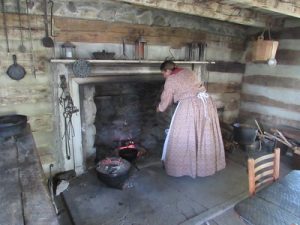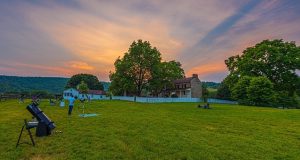Local News
The Scarecrow of Hazard Mill
Under the Black flag – Shenandoah Valley 1864
There has never been a more wretched hive of murder and villainy than existed in the vicinity of Front Royal in the fall of 1864. Union Brig. General Wesley Merritt described the area as a “…paradise of bushwhackers and guerrillas.” Soldiers and civilians were murdered everywhere in cold blood while either traveling along the roads or in their homes.
From August through October of 1864 a host of demons descended upon the Front Royal community. Federal and Confederate Raiders roamed the countryside, essentially operating under the black flag of anarchy, giving no quarter. Each side executed prisoners and dragged them through the streets. Meanwhile, deserters and marauding bands of outlaws flourished in the mass disorder, and rape and looting went unchecked for months. Refugee women and children trudging northward from burning farms with all their belongings were easy prey for bushwhacking outlaws.
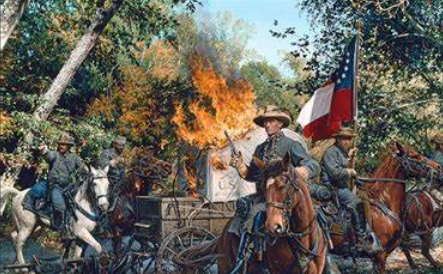
“FIRE IN THE VALLEY, The Berryville Wagon Train Raid” art by John Paul Strain.
In one of the most heinous instances of brutality, the towns people of Front Royal looked on in horror, as Federal cavalry dragged six of Mosby’s Raiders through the town – their band playing the death march. Two of the Rangers, David Jones and Lucian Love, were dragged out of the procession, lined up and shot in front of a church and left to die. While that was occurring, another Confederate horseman, Thomas Anderson, was dragged by horse through the streets to a nearby tree and shot in the head. His hands still tied.
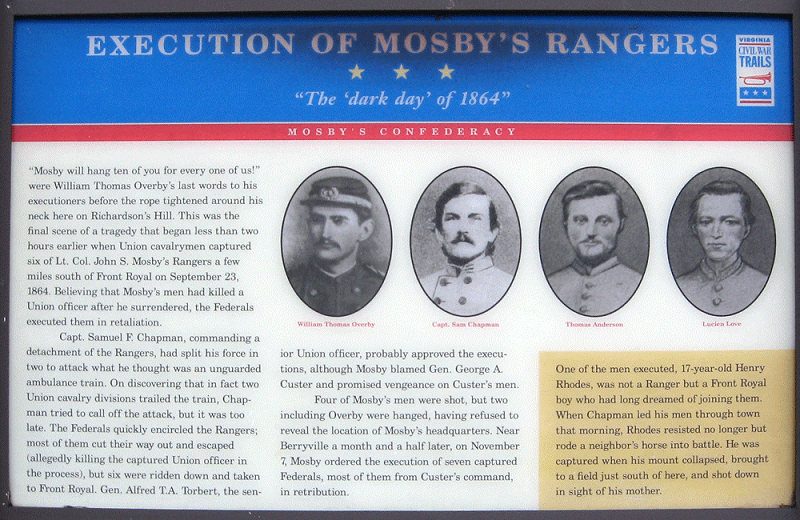
A couple more cavalrymen rode through Front Royal’s main streets, dragging 17-year-old civilian Henry Rhodes behind them. Young Henry Rhodes was not a member of Mosby’s Rangers. He was a 17-year-old resident of Front Royal that had long dreamed of riding with Mosby’s men. He had remained at home to support his widowed mother and a younger sister. When Mosby’s Rangers rode through the town on their way to attack a Yankee ambulance train, Rhodes could not resist and mounted a neighbor’s horse and joined his heroes. His horse, however, collapsed during the race toward Chester Gap, and the teenager was overtaken by the Federals.
Henry Rhodes was paraded by his home that same morning, his arms lashed to the saddles of two Union cavalrymen, who dragged the youth up Chester Street. When Mrs. Rhodes saw her son, she ran screaming to him, hugged him and pleaded with the Yankees to spare his life. One of the Yankee cavalrymen brandishing a saber, threatened to behead both mother and son. A young man’s dream had become a family’s nightmare.
The troopers were men from Custer’s Michigan brigade. When the procession passed in front of young Henry’s mother, the cavalrymen stopped and dismounted. The sergeant in charge untied the ropes and Rhodes stumbled and fell. His wailing mother pleaded for mercy as the town’s people gathered along the fence railings to watch. The inflamed Union soldiers mounted on their horses taunted the prisoner. The cavalrymen surrounding the sergeant cheered and yelled “shoot him Cline” to the red bearded sergeant standing over the hated Mosby criminal.
An eyewitness account told of Henry Rhodes’s final seconds of life. A young girl, Sue Richardson, stated that his executioner, identified by the shouts as Sergeant Cline (later identified as Willie Cline), “ordered the helpless, dazed prisoner to stand up in front of him” while he emptied his pistol into his face in front of his mother.” The name and vision of Sergeant Willie Cline was instantly seared in the memory of that on-looker.
From the window of her house, Miss Richardson had watched. She knew Henry Rhodes and was probably close to him in age – and she never forgot his death. The scene haunted her, and she wrote in her diary: Such excitement and cruelty as never was witnessed here before … that poor Henry Rhodes should be shot in front of our door. The crowd assembled around him, then we had the pain of seeing the cavalry horses pass over him before his body was removed and left in a wheelbarrow at his mother’s door. His poor mother is almost crazy. I will not sleep until I get the name of this villain to Mosby.
The last two prisoners, William Overby and a man called Carter, were led off to be hanged by a huge and wrathful crowd of soldiers. Overby and Carter were taken to a large tree outside of town and offered freedom if they disclosed the location of Mosby’s headquarters. They both refused, and with hands tied behind their backs they were summarily hanged and left swinging for several hours. A sign was attached to Overby’s body reading, ‘Such is the Fate of All Mosby’s Gang.’ Custer’s men left them hanging to ensure all the townspeople witnessed the justice – knowing Mosby would get the message. He did.
Enraged, Mosby’s men responded by cold bloodedly shooting Lieutenant John Meigs from his horse in vicinity of Custer’s headquarters. ‘In tears, Custer wept for his unfortunate orderly, who he said was ’shot down like a dog and stripped of all but his trousers.’ A short time afterwards, Custer exclaimed, “Lookout for smoke” – and soon you could track Custer’s vengeance as ugly columns of smoke started to rise in succession as he moved up the valley. He burned down all the farms and houses in a five-mile radius.
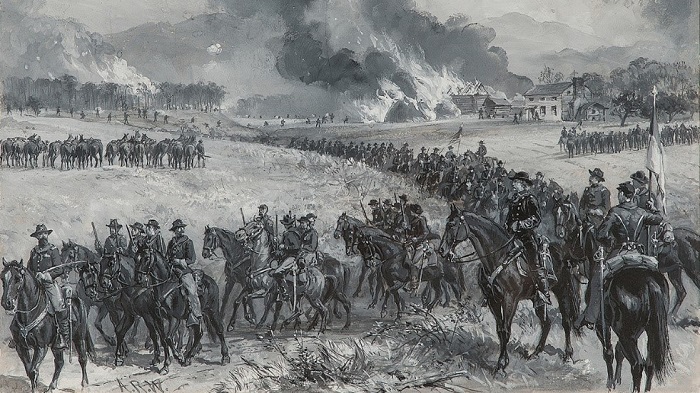
Painting entitled, “Sheridan’s Ride” by Thomas Buchanan.
Mosby’s guerrillas followed the smoke too and mercilessly killed any Union soldiers they could find – leaving them along the roads, with throats slit or hanging from trees. No quarter was the policy adapted by all sides. The Rangers searched relentlessly for Sergeant Cline but could not find him. Before killing the unfortunates, the Rangers pressed their prisoners for information about Sergeant Cline – but to no avail. All they had was a physical description and that he was in the Michigan cavalry.
Correspondent Francis Long of the New York Herald wrote, ‘The intervening country between Harrisonburg and Winchester is literally swarming with guerrillas,’ Grant urged Sheridan to continue destroying whatever was useful for ‘if the war is to last another year, we want the Shenandoah Valley to remain a barren waste.’
The Burning
For five days Custer tore into an 85-mile Shenandoah stretch, from Winchester to Waynesboro, burning mills, barns, houses, and granaries, destroying bridges and ripping apart railroad track. Custer exclaimed, “I will put the fear of Hell in these people.”
Mosby struck back with vengeance. On October 11, guerrillas ambushed and killed Lt. Col. Cornelius Tolles, Sheridan’s chief quartermaster, and Dr. Emil Ohlenschlager, Sheridan’s medical inspector.
Federal retaliation swiftly came on October 13, when Union Colonel William Powell hung Ranger A.C. Willis from a small tree and left him. Davy Getz met a similar fate. Getz was a mentally retarded man captured by Custer’s forces while hunting with a squirrel gun near Woodstock. Presumed to be a bushwhacker, he was marched to Harrisonburg and hung despite prolonged pleas from the residents. Vengeance begat vengeance.
When one of Custer’s ‘burn patrols’ was overrun by Mosby’s men – the Rangers lined up about 25 of them and executed them on the spot. Several more of Custer’s men were captured and hung as close to Custer’s camp as possible. Three more of Custer’s men were hanged along the side of the Valley turnpike. Hanging was slow work, so Union soldiers were often systematically lined up and shot with pistols at point blank range. The merciless killings and hangings by both sides went on for weeks.
Union devastation of the Shenandoah Valley continued into late October as Sheridan’s forces pushed the Southern army south beyond New Market.
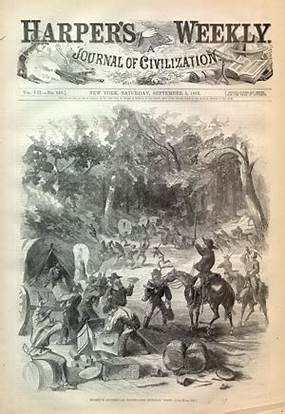
John S. Mosby Raid drawing featured in September Harper’s Weekly edition 1864.
Bands of Mosby’s men roamed both sides of the valley along with countless deserters and outlaws. They often snuck into Union camps at night using rainstorms to mask their sounds and cut the throats of anyone they found. In one such incident, a small band of raiders snuck into a Federal ‘hastily configured overnight campsite.’ The site was in disarray as it had recently fended off an attack from bushwhackers and they were low on ammunition.
After a brief firefight, the Rangers yanked all the wounded out of the wagons and sat them together in the rain under guard while they plundered the wagons. No one paid much attention to the prisoners until one of the Rangers overheard a conversation amongst the prisoners addressing Sergeant Cline. When questioned by Mosby’s men – it was clear that Sergeant Cline was with Custer’s Michigan cavalry. He also fit the description given by Miss Richardson. Alas – they had captured the murderer of Henry Rhodes.
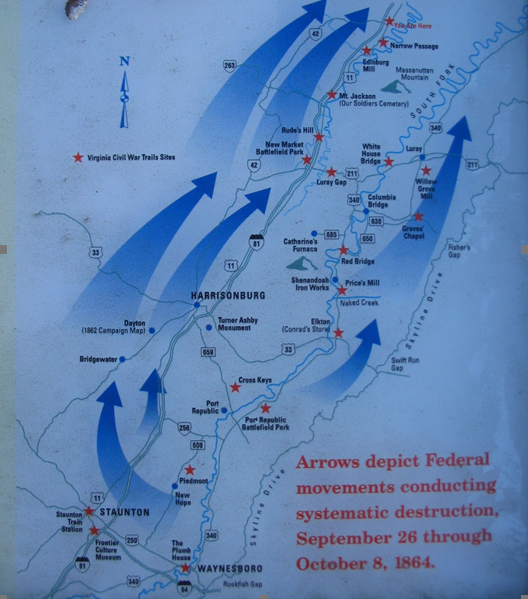
They quickly segregated him from the rest of the prisoners and fled into the darkness with the wounded Cline in tow. Just before dawn, the small band of horsemen was spotted by Union cavalry and took flight westward down the hill fording the South Fork of the Shenandoah River towards the safety of the forest. After evading the enemy for a couple hours the Rangers forded several streams and took refuge along the west bank of the river at the site of a burnt down mill – known locally as Hazard Mill. Ironically, the mill had been owned by a Unionist that did not support the Southern cause. The site had apparently been contested during the ‘burning campaign’ as over a dozen bloated corpses and many spent cartridges still littered the area. The bodies were mostly stripped of clothing and possessions – likely the victim of deserters hiding in the hills.
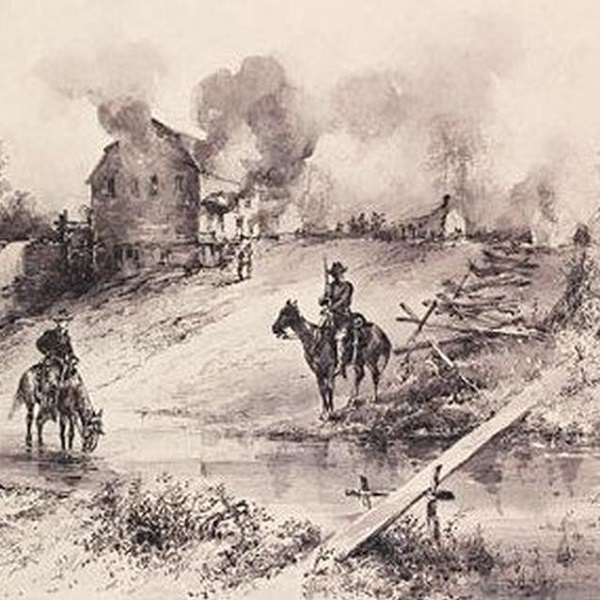
Drawing attributed as “War to the Hilt” by US National Park Service.
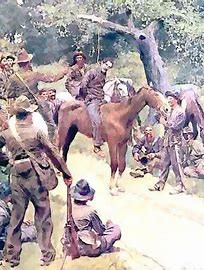
“They talked it over with me sitting on the horse,” by Howard Pile.
Legend has it that the Rangers coerced Cline into admitting the brutal murder of Henry Rhodes. He reportedly showed no remorse. After a little taunting of their own, the Rangers assembled everyone to watch the spectacle. Willie Cline was placed on a horse with hands tied behind his back and was hung from a tree within site of the old mill.
Aftermath: By December, the war moved eastward, and the belligerents departed the valley. The war in Virginia ended the following spring and Mosby disbanded his command shortly afterwards about 22 miles east of Front Royal. Many of his Northern adversaries headed west to fight Indians. Mosby’s principal foe, General Custer, died with all his men about 12 years later at the Battle of the Little Big Horn.
After the hanging of Cline, members of Mosby’s force informed Sue Richardson of the revenge.
According to Miss Richardson’s diary dated in May 1864 (after Lee’s surrender) she’d heard stories of a Union soldier (known as the Scarecrow) still hanging from a tree near the ole Hazard Mill site. One weekend, she and others ventured out on a day trip on horseback in search of the scarecrow. She wanted to be sure it was really Cline. A local boy took them to the site. There they discovered Cline’s decayed body still swinging from the tree. “His blue blouse had faded considerable, and the crows had picked away at him clean – but it was him for sure. His ‘orange tinted’ hair billowed in the wind and his lifeless body gently drifted left and right when the breeze whipped up. As I gazed at him, I couldn’t remove the vision of Rhode’s poor mother wailing in agony on Chester Street. Cline got what he deserved. We left him swinging.”
Sergeant Willie Cline joined the list of many souls who were never accounted for during the valley war of 1864, however, few would be remembered as he was.
 The story of the Scarecrow of Hazard Mill grew over the years and children would hide behind trees and watch it at night to see if it came alive. Unruly children were often threatened that the scarecrow would come for them unless they behaved. Locals used the site as a reference point for directions. The morbid site was known to most people in the area, but no one removed it from the tree. Allegedly, he continued to swing for years. The people felt they would be doing an injustice to the widow Rhodes if they cut him down. Later, stories circulated that his crumpled remains formed a pile next to the tree that bore his weight. As time passed his remains disappeared and only the legend remained. In the late 1800s, a few locals would occasionally hang a scarecrow in a tree in reference to the scarecrow stories.
The story of the Scarecrow of Hazard Mill grew over the years and children would hide behind trees and watch it at night to see if it came alive. Unruly children were often threatened that the scarecrow would come for them unless they behaved. Locals used the site as a reference point for directions. The morbid site was known to most people in the area, but no one removed it from the tree. Allegedly, he continued to swing for years. The people felt they would be doing an injustice to the widow Rhodes if they cut him down. Later, stories circulated that his crumpled remains formed a pile next to the tree that bore his weight. As time passed his remains disappeared and only the legend remained. In the late 1800s, a few locals would occasionally hang a scarecrow in a tree in reference to the scarecrow stories.
For years after the conflict the fall of 1864 was known by Valley residents simply as ‘the Burning.’ The Civil War departed the Valley, but it left permanent scars on the land, and on its residents. Hatred towards the north continued for decades until those that lived the era and their offspring had passed on.
Today, it’s difficult to find anyone familiar with the ‘Scarecrow’ legend and you wouldn’t know there was a war in the valley at all, if not for the descriptive “Civil War Trails’ signs. Many families have come and gone over the 150-plus years since the burnings. Many of the locals that lived in the valley during the war fled the area afterwards for a more promising life in nearby towns. Some places in the valley remained untenable for years. There was no livestock, no barns or houses or stores for miles in some stretches. Those that later inhabited the Bentonville area heard the hills were haunted and stayed away from the ole mill. Today, the dirt road to Hazard Mill still bears its name. The ruins of the ole mill remain but the acreage is now part of the George Washington National Forest.
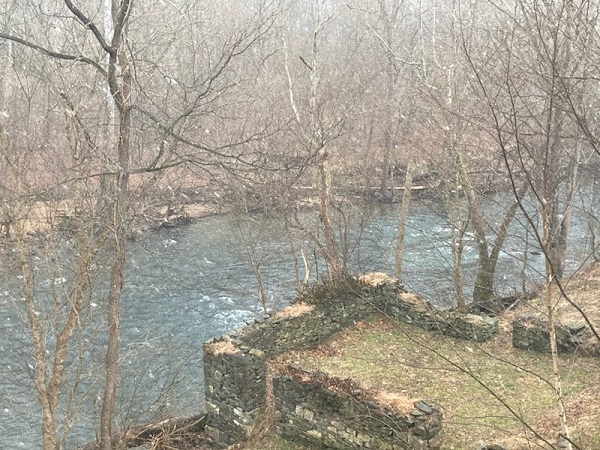
Photograph taken by Lt. Colonel (Ret.) John Morgan.
There is only one residence within the National Forest near the site. The actual Hazard Mill site is owned by Lt. Colonel (retired) John Morgan and his wife Sonja. Mrs. Morgan is quick to tell you that the area is “definitely haunted” and can regale you with many tales of such. The colonel acknowledges that the area is full of energy and occasionally erects a scarecrow in October to commemorate the legend. The local Equestrian club reports that during their annual October ride through the National Forest, they occasionally see a ‘Halloween-like’ skeleton cloaked in Yankee blue hanging on the legendary hill above Hazard Mill.
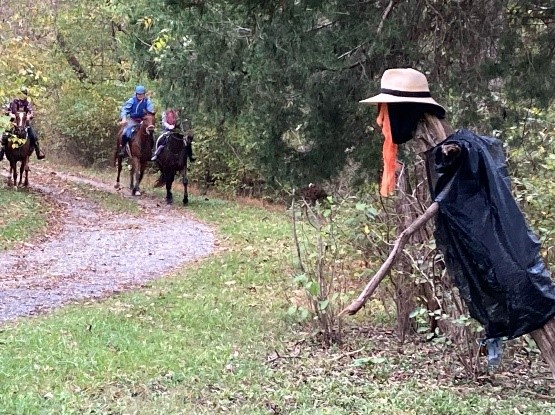
Photograph taken by Sonja Morgan.
(Portions of the details of the Valley war and the story of Henry Rhodes were extrapolated from “Mosby’s Rangers” by Jeffrey D. Wert, 1990).
Local News
New Medic Unit Unveiled: A Boost for Community Safety
Fire Chief James Bonzano kicked off the unveiling of the new medic unit before turning it over to Captain Austin Cucciardo. “This is our new medic unit. It’s a significant investment, and we want to thank the board of supervisors and administration for their support. Special thanks to Alyssa and her crew for their hard work. We know it was tough, but we’re really happy,” said Bonzano.

Fire Chief James Bonzano starts unveiling the new medic unit, expressing gratitude to the Board of Supervisors and administration for their support.
He emphasized the need for the new unit due to the old, sometimes unsafe equipment the team had been using. “This was really needed, and we’re very appreciative,” he added before handing over to Captain Cucciardo, who oversaw much of the work on the new units.
Cucciardo detailed the features of the new 2023 Ford F-450 chassis. “It’s the first of five new units. We chose a gas engine for significant cost savings upfront and reduced maintenance costs,” he explained. The gas engine saved around $15,000 initially and is cheaper to maintain in the long run.

Captain Austin Cucciardo shows the new medic unit to the Board of Supervisors, highlighting its advanced features and the significant improvements over older equipment.
Highlighting the advancements, Cucciardo pointed out the cooling bar that provides 50% more airflow and 30% better temperature regulation, essential for comfort in the back of the ambulance. “Anyone who has been in the back knows how important temperature regulation is,” he said.
One major update is the electronic control screen, both in the front and rear, allowing better operation management. “Teams can control lights and other functions from both ends of the unit, enhancing safety and efficiency,” noted Cucciardo.
The new power load system for stretchers, capable of handling up to 870 pounds, was another significant upgrade. “This system removes the physical strain of lifting stretchers, reducing the risk of injury for our personnel,” Cucciardo said.
The units now feature a four-point harness for improved safety and a liquid spring suspension system for a smoother ride, which is crucial for patient comfort, especially on rough roads. “It significantly improves riding conditions and reduces maintenance costs compared to traditional air ride systems,” Cucciardo explained.
The new medic units will be distributed across various stations, starting with Linden, then Front Royal and North Warren. This rotation system ensures that each station receives the new units efficiently and maintains a reserve fleet for backup.
The community’s response has been overwhelmingly positive. The investment in new equipment reflects a commitment to safety and efficiency, benefiting the emergency responders and residents.
Special Thanks to Mark Williams, Royal Examiner, for this exclusive video.
Local News
Julia Wagner Animal Shelter Closing for Construction in July: New Contract Signed with WC for Animal Control Services
Front Royal’s Julia Wagner Animal Shelter on Progress Drive closes for three weeks starting July 1 while interior construction projects, including new floor tiling throughout, are completed. The work is expected to take until July 22.
Shelter Executive Director Kayla Wines said dog adoptions will continue by appointment at the shelter while adoption events for cats and kittens will be hosted at the Front Royal Petco store and at the Humane Society of Warren County’s “Pick of the Litter” thrift store.
Wines said adoption fees are waived through the end of June “in an effort to clear some space.”

“We are asking the public for their patience as we navigate the next few weeks. We’ve got a lot of heavy lifting to do to prepare for the work being done and will appreciate any volunteer help offered,” she continued.
If you are able to lend a hand the first week of July, reach out to Wines at director@humanesocietywarrencounty.org
Meanwhile, through the HSWC’s most recent newsletter, Wines announced a successful updating of its contract with the County of Warren and the Warren County Sheriff’s Office to continue providing locating, intervention, and pick-up response-centered services to the shelter’s housing service for the community’s stray, abandoned, abused and homeless animals. The agreement will be in place from July 1, 2024, until June 30, 2027, with the County initially providing $412,000 for the first year with a 2% annual increase over the three-year period. Wines paid tribute to this year’s new sheriff, Crystal Cline, whose predecessor had folded the Animal Control Program, assigning general duty deputies to the task.
Wines paid tribute to the members of the new Warren County Sheriffs Animal Control team, describing them as “compassionate, dedicated, animal loving, hard-working officers … We are very proud to have such a wonderful relationship with our local law enforcement and first responders again.”

Sheriff Crystal Cline plays with one of the shelter dogs. Courtesy Photo-Graphics HSWC
The deputies now participate in a new “First Responder Wednesday” program where a deputy comes to the shelter and poses with an adoptable animal. “Not only does this help the pets in our care with socialization,” Wines said, adding that sharing posts with animal control helps reach a wider audience and assists with creating “happily ever afters for our adoptable pets.”
Wines also reported on the shelter’s latest rabies and microchip clinic (840-B John Marshall Highway) at which Landry Renovations & Repair on June 15 provided 85 free rabies vaccines and 20 microchips for needy pet owners. Throughout last year, the shelter provided trap, neuter and release (TNR) services for 368 feral cats. The treatments are aimed at keeping the feral cat populations down.
“Did you know,” Wines teased, “that two feral cats and their offspring can turn into 400,000 cats in just seven years!” she said, adding that “all the TNR surgeries were done at our very own HSWC spay-neuter clinic.” Since each surgery conducted by the two veterinarians at the clinic cost about $75 each, Wines is asking shelter members and others to consider making donations to the two-year-old clinic by calling 540-635-4734 or by mailing a check to HSWC, 1245 Progress Drive, Front Royal, 22630.

Local News
Bret Hrbek Becomes District Governor, Leading Rotary Clubs in Virginia and Tennessee
Following two decades in the Rotary Club of Front Royal, in which he became club president in the year 2019-2020, Bret Hrbek, on Monday, June 24, became the top Rotarian in the region.
His appointment as District Governor – head of all Rotary clubs in a two-state region, Virginia and Tennessee – came at a lavish dinner hosted at the Shenandoah Valley Golf Club attended by former district governors and Rotarians from various clubs in the area. Those included past district governor and court judge Ron Napier of Front Royal, who performed Hrbek’s installation.
In his introduction to his Rotary colleague, Napier said: “Having excelled as a club leader and club president, Bret envisioned a larger role in Rotary. He started to understand that community needs are not all local but exist worldwide.” Napier described Hrbek’s 2017 visit to India, his coordination of a water project for the needs of Uganda, a more recent visit to the Rotary International convention in Singapore coupled with later visits to Dubai and, again, Uganda.

Rotarian and retired judge Ron Napier traces Hrbek’s history with Rotary leading up to his Monday, June 24 installation as Governor of District 7570 as Hrbek listens to Napier’s right, along with his wife Jessica and incoming FR Rotary Club President Holly Rhodenhizer. Below, the supporting line has grown to include a string of supporting Rotarian officials. Ring that bell, Ron! Royal Examiner Photos Roger Bianchini

“Bret is teaching his next generation the importance of service,” Napier told a packed crowd of diners. He noted that in 2021, Hrbek received his district’s (7570) “Douglas A. Newton Excellence in Communications” award for elevating the Front Royal club’s weekly newsletter.
According to his lengthy (and impressive!) biography, Hrbek, a financial advisor with Edward Jones in Front Royal for the past 24 years, has earned a plethora of community awards: among them, he won the Front Royal-Warren County Chamber of Commerce “Citizen of the Year” award in 2018; the Front Royal Methodist Church Service Candle (2014); the aforementioned excellence in communications award (2021); and the Ted Jones “Spirit of Caring” award (2019 and 2021).
Hrbek received his BA in Political Science and Economics from Virginia Tech and a Master’s in Financial Planning from Bentley University, Waltham, Massachusetts.
In his address, Hrbek said, “We live in a world where conflict and division are all too common, but we, as Rotarians, have the power to be agents of change. Through educational programs, peace fellowships, community-building projects, and so on, we can foster an environment where dialogue and understanding replace hostility and mistrust.”

The crowd, including family members front and center, rises to applaud Hrbek’s installation as District 7570 governor. Below, during his acceptance remarks, Hrbek looked hopefully toward a “peaceful” and “free” future in which Rotary International can help contribute to increasing “dialogue and understanding” in place of “hostility and mistrust” on the global stage. But that effort must always begin locally on the home and regional front; the new district governor reminded us. But there were lighter moments too, as outgoing officers were urged to open farewell gifts so all present could see what they found in there.


“Promoting peace doesn’t mean we have to solve global conflicts … peace starts at home. When it comes to peace, think globally but act locally,” he said. To his family – wife Jessica, children Noah, Annie, Hunter, and Luke, he said, “You are my ‘why,’ and I want to ensure we continue to live in a peaceful and free country.”

The writer and fellow Rotarian share a congratulatory moment with the incoming district governor before the official start of Hrbek’s installation as Rotary District 7570 governor. Below, a series of Rotary banners begins from the left, with the Rotary 4-way test, an important one to apply at all levels, as Hrbek would remind us during his acceptance comments.

Local News
New Rules for Farm Use Vehicles Effective July 1
Virginia farmers take note! Starting July 1, 2024, new regulations for farm-use vehicles will be enforced. These rules, enacted by Virginia lawmakers in 2023, require unregistered farm-use vehicles to display a DMV-issued permanent farm-use placard. The placard must be prominently displayed on panel trucks, pickup trucks, and sport utility vehicles with a gross vehicle weight rating (GVWR) under 7,500 pounds.

Details of the New Regulation
Key Requirements:
- Placard Purchase: Farm vehicle owners must buy a DMV-issued placard for $15. This placard is valid for the lifetime of the vehicle.
- Application Process: Owners must apply for a local DMV Select or full-service DMV location. The application must include information about the farm’s location, size, and commodities, along with signed statements confirming the vehicle’s exempt use and insurance coverage.
- Display of Placard: The placard must be displayed on the front and back of the vehicle starting July 1, 2024.
- Penalties for Non-Compliance: A first violation will result in a fine of up to $250. Subsequent violations will also be fined $250 each.
Purpose of the New Rules
The new law ensures that farm use tags are used appropriately and that Virginia’s roads are safer. “As farm vehicles are key to agricultural productivity, it is important that Virginia farmers can continue to use them in their operations while preventing farm use tags from being used on other vehicles inappropriately,” said VDACS Commissioner Joseph Guthrie.
Conditions for Farm Use Vehicles
Eligible vehicles must meet specific criteria to qualify for the DMV-issued farm use placard:
- Agricultural Use: The vehicle must be used exclusively for agricultural or horticultural purposes on lands owned or leased by the vehicle’s owner and not operated on public highways except for specific purposes.
- Limited Highway Use: Vehicles can operate on highways for up to 75 miles to transport farm produce and livestock or to reach storage houses, packing plants, markets, or sawmills.
- Seasonal Use: Vehicles can be used seasonally for specific agricultural activities, including transporting produce, livestock, and essential supplies.
- Special Exemptions: Vehicles drawn by farm tractors and used for specific agricultural purposes, such as transporting unginned cotton, peanuts, or fertilizer, are also eligible.
Exemptions and Insurance Requirements
Certain farm vehicles are exempt from needing the DMV-issued placard:
- Vehicles Over 7,500 Pounds: Farm vehicles with a GVWR greater than 7,500 pounds are exempt.
- Specific Machinery: Vehicles with attached machinery for spraying plants or specific agricultural purposes are also exempt.
All unregistered farm-use vehicles must be insured under a general liability policy that includes personal injury and property damage liability insurance. Failure to provide proof of insurance within 30 days when requested by a law enforcement officer is a traffic infraction punishable by a $600 fine.
Encouragement from Authorities
DMV Commissioner Gerald Lackey urged farmers to comply with the new regulations: “There is not much time left before enforcement begins, so we encourage farmers to bring their filled-out applications to their local DMV.” Similarly, VSP Superintendent Colonel Gary Settle highlighted the importance of the 12-month grace period, stating that it provided farmers ample time to familiarize themselves with the new requirements.
Conclusion
Virginia farmers must act now to ensure compliance with the new farm use vehicle regulations. By purchasing and displaying the DMV-issued farm use placard, farmers will adhere to the law and contribute to the safety and proper use of Virginia’s roads. For more information and to begin the application process, visit your local DMV Select or full-service DMV location.
Local News
Bel Air Added to the Virginia Landmarks Register
Bel Air, a historic mansion in Front Royal, has been added to the Virginia Landmarks Register to recognize Virginia’s rich historical heritage. This property, built in 1795, stands as a testament to the architectural and historical evolution of the region. Initially constructed in the Federal style, Bel Air has witnessed numerous pivotal events and transformations, reflecting its storied past.

Bel Air Mansion. Photo by Maral Kalbain, 2023
Early History and Construction
Bel Air is located in Front Royal, Virginia, a once bustling center of economic and agricultural activity in the Shenandoah Valley. Captain Thomas Buck, one of Front Royal’s founders, constructed the mansion. The central brick portion of Bel Air was built around 1795, with earlier log wings predating it. According to family lore, these log wings were among the first structures on the property, signifying the Buck family’s early settlement in the area.
Captain Thomas Buck was a prominent figure in the region. Born in 1756, Buck served in various significant roles, including as a Lieutenant in the Virginia Militia, a Captain in the 8th Virginia Regiment during the American Revolution, and a trustee of Front Royal. Under Buck’s ownership, Bel Air evolved into a substantial estate, reflecting the prosperity and status of its inhabitants.
The Buck Family and the Civil War Era
Bel Air remained under the Buck family’s ownership for more than 125 years, during which it witnessed significant historical events, most notably during the Civil War. Lucy Rebecca Buck, a young resident at the time, chronicled her experiences during the war and the Union forces’ occupation of Bel Air in her diary. Her detailed accounts provide a vivid picture of life during the tumultuous period.
Bel Air’s significance is further underscored by its notable visitors during the Civil War, including Confederate spy Belle Boyd and Confederate General Robert E. Lee. General Lee’s visit to Bel Air is well-documented, with local folklore recounting how he enjoyed a glass of buttermilk on the front porch and interacted with the Buck family.
Architectural Evolution
In 1905, Bel Air was sold to the Downing family, marking the first time the property passed out of Buck’s hands. The new owners undertook significant renovations to the house, transforming it into a Classical Revival-style residence. Local builder Gustave A. Beyer spearheaded these renovations, which included removing the original log wings, adding a grand portico, and updating the interior layout and trim.
Despite these changes, Bel Air retains many of its original features. The mansion’s oldest segment, a five-bay, two-story brick structure, rests on a stone foundation. The 1905/1906 renovations added a monumental portico supported by stuccoed columns with Modern Ionic capitals. The house’s exterior walls were stuccoed, and the original multi-light windows were replaced with one-over-one wooden sash windows.
The interior of Bel Air combines elements of the Queen Anne and Classical Revival styles. The entrance hall features a grand staircase, a naturally finished paneled wainscot, and a Queen Anne-style mantel. The dining room, added during the 1905/1906 renovation, matches the hall’s trim, while the rear ell houses a pantry, kitchen, and additional living spaces. The second floor contains bedrooms with Queen Anne-style mantels, and the attic holds three rooms with original wide pine board flooring and hand-riven lath beneath the plaster.
Historical Significance
Bel Air’s inclusion in the Virginia Landmarks Register underscores its importance as one of the most significant residential properties in Front Royal. The property’s rich history, architectural evolution, and association with prominent historical figures make it a vital link to the past.
During its time, Bel Air has known only three sets of owners since the late eighteenth century, maintaining a direct familial connection to the original settlers. Its connections to historical developments and subsequent evolution make Bel Air a remarkable testament to the past. It vividly illustrates the transformation of early Federal-style brick dwellings through to the early twentieth century.
Archaeological Potential
The grounds surrounding Bel Air offer substantial archaeological potential. The area includes remnants of nineteenth-century domestic and agricultural outbuildings and sites of Civil War activity. The ruins of a stone chimney on the property could reveal insights into the estate’s early domestic arrangements, further enriching our understanding of Bel Air’s historical context.
Bel Air’s addition to the Virginia Landmarks Register celebrates its historical and architectural significance. The mansion not only represents a key part of Front Royal’s heritage but also serves as a testament to the enduring legacy of the Buck family and the broader historical narrative of the Shenandoah Valley. As a preserved piece of history, Bel Air offers a window into the past, inviting public interest and scholarly research into its storied legacy.
Local News
Rob Grimm Named Rotarian of the Year by Rotary Club of Warren County
The Rotary Club of Warren County (RCWC) presented its annual “Rotarian of the Year” to Rob Grimm at its Wednesday, 12 June meeting at the First Baptist Church of Front Royal Fellowship Hall. Rob has been an active club member since 2013, serving as a past Treasurer and Past President. Rob currently serves on the meeting day technology team, ensuring our Zoom feed works well and recording and posting our meetings to our club website.
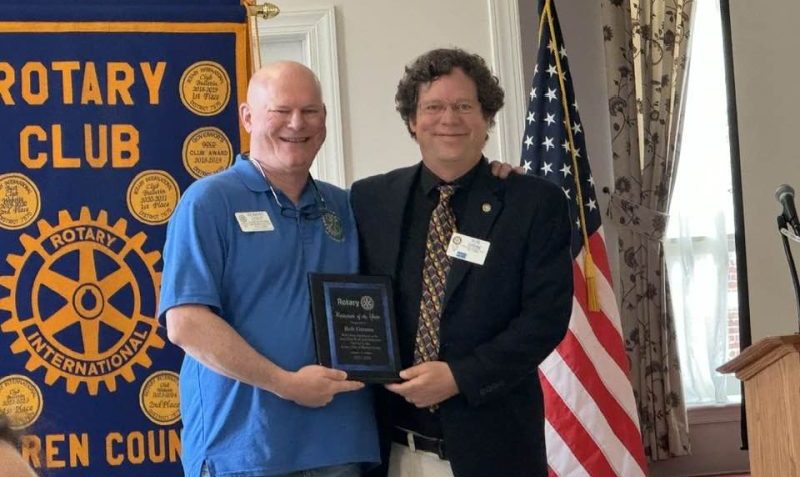
Rotary Club of Warren President Michael Williams and Rob Grimm, Rotarian of the Year.
Current RCWC President Michael S. Williams stated: “Rob is the epitome of Service Above Self (Rotary’s Motto). Rob gives so much of himself to our club behind the scenes, in areas no one knows about, and that’s just fine with Rob. Specifically, this Rotary year, Rob helped us resolve some issues that required Rob’s skill set to be resolved promptly. Rob immediately stepped up, asking for nothing in return. He was just happy to help his club. I am proud to call him my fellow Rotarian and my friend.”








